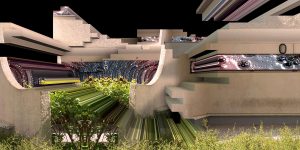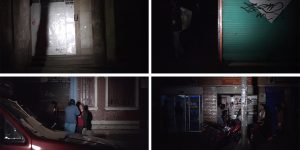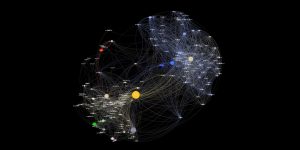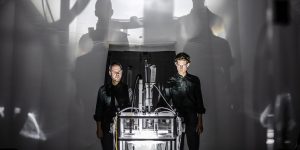documentation

Machine for Living
Sabrina Ratté (CA)
Machine for Living is a project elaborated in the context of a nine-month residency at Château Ephémère (Carrière-sous-Poissy, France). The video series investigates the architecture of the new towns (villes nouvelles) and brutalist residential buildings in the surroundings of Paris.

Calle 22
Julius von Bismarck (DE)
Calle 22 is Julius von Bismarck’s documentation of the street of the same name in Bogota, Colombia. With a high-speed camera and a spotlight, he shoots over 2500 frames per second during a car ride at high speed along the southern side of Calle 22 at night, thus capturing the varied life on the road with a powerful light. As this leads from the prosperous parts of the city to the poor quarters, he presents the urban development in a very small space and reflects the political process of a city based on one road.

Topography of the Information Warfare
Vladan Joler (RS)
Governments, political actors and companies are now experimenting with more sophisticated ways (harder to detect and document) of exerting internet control and disturbance in the information flow. The aim of this analysis was to explore (and visualize) some of the forms and methods of interventions that various political actors or power structures have been using to control and conquer various online spheres. Here we mostly focused on hidden, indirect actions, interventions by unknown actors, companies without visible ties to government officials, political troll armies and troll lords and “artificial” entities. This map is based on a 5-year internet monitoring process and over 400 different cases of violations documented and analyzed by the Share Foundation. Though different methods represented in this map are observed in our local context, we believe that they are also being used worldwide in similar forms. This map is an attempt to interconnect most of those issues into one map, one possible narrative, one possible reading of those processes.

VFRAME: Visual Forensics and Metadata Extraction
Adam Harvey (US), Josh Labouve (US)
In conflict zones around the world, serious human rights violations repeatedly occur through the use of illegal munitions. VFRAME shows how surveillance technologies can be used to document such violations – for example in the Syrian conflict. A visual search engine was trained to analyze video data sets from battle zones to spot such weapons. In order to train the neural network of the search engine to recognize them even in low-resolution recordings, 3D models were created and fed into the object detection software.

Voices from AI in Experimental Improvisation
Tomomi Adachi (JP), Andreas Dzialocha (DE), Marcello Lussana (IT)
Through machine learning, computers can recognize patterns in a variety of sound documents. But can they also learn to improvise musically? The software “Tomomibot” tries it out by interacting in real time with the sound artist Tomomi Adachi, using deep learning techniques. The Artificial Intelligence (AI) "learns" the artist’s individual style via voice recordings and directly confronts him with the newly generated material. Their joint performance shows how interactive technology and AI can influence a (vocal) style. However, this dialogue also makes clear that the artist will always be more creative and unpredictable than his mechanical counterpart.

Polar Force
Speak Percussion, Philip Samartzis (AU), Eugene Ughetti (AU)
Polar Force is a phenomenological investigation of the windiest, coldest, and driest continent on earth: Antarctica. During the one-hour work, vivid multichannel Antarctic field recordings of wind, water, and ice are combined with new instruments, sampled in a live performance and a choreographed artistic “lecture” undertaken by two performers reminiscent of scientists in a remote polar field station. The immersive live performance merges the art-science-tech to comment on geopolitical issues and the climate crisis.


